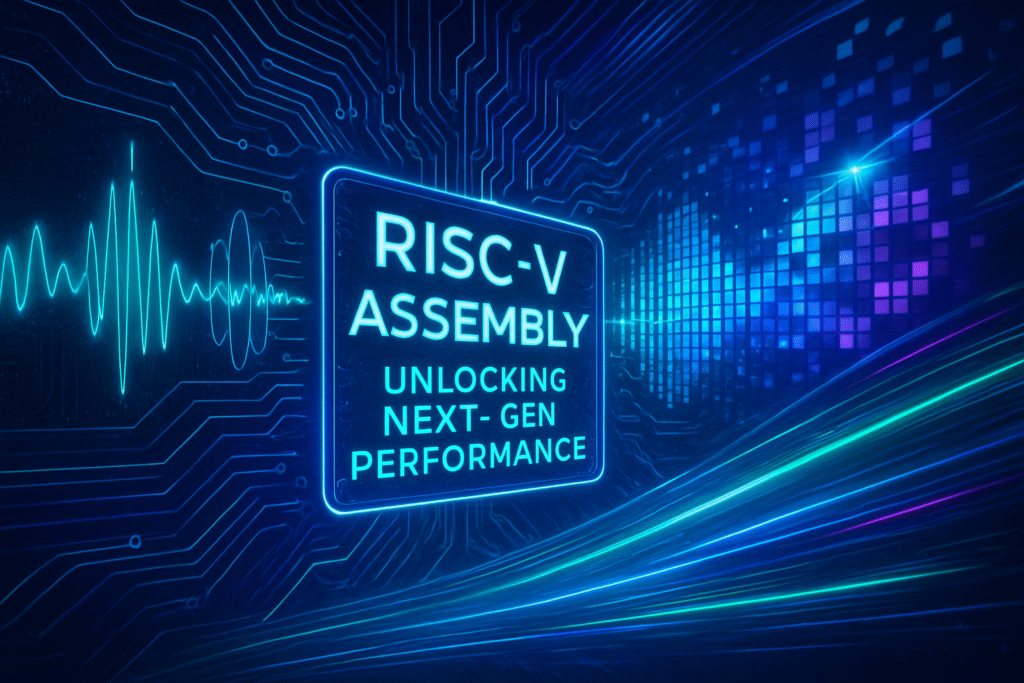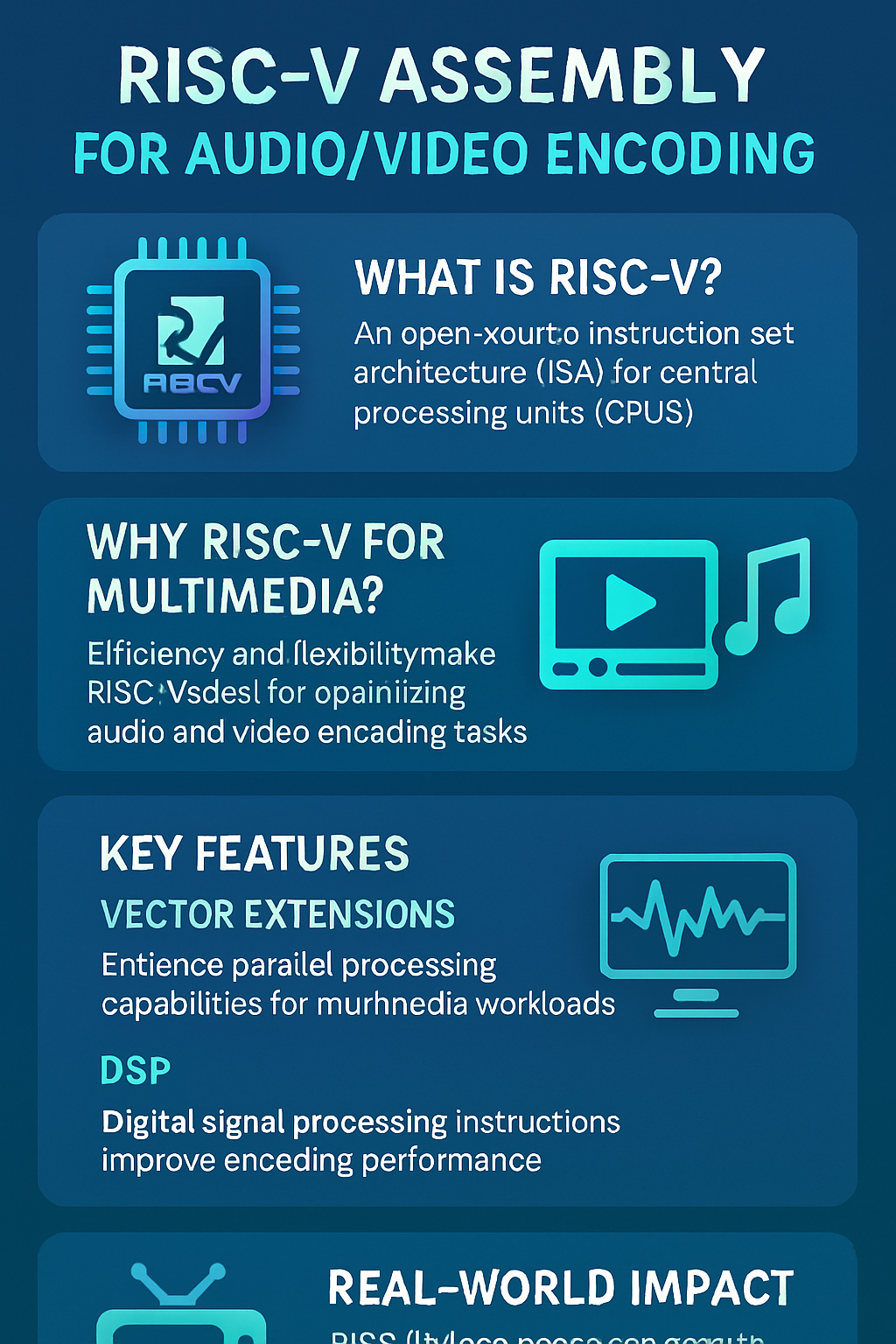
Hey there, fellow tech enthusiasts! Have you ever wondered what makes your favorite streaming services deliver such crisp audio and stunning video?
Or how those incredibly detailed video games manage to render complex scenes so smoothly?
A lot of it boils down to efficient encoding and decoding, and that’s where the world of assembly language and specialized processor architectures comes into play.
Today, I want to talk about something truly exciting that’s shaking up this space: RISC-V Assembly.
It’s not just another buzzword; it’s a powerful, open-source instruction set architecture that’s rapidly gaining traction, especially in the realm of audio and video encoding.
We’re on the cusp of a new era where performance and efficiency are redefined, and RISC-V is at the heart of it.
For years, proprietary architectures have dominated the landscape, but RISC-V is changing the game.
Its open nature fosters innovation and customization, allowing developers to tailor solutions precisely to their needs.
This flexibility is proving to be a significant advantage, particularly for demanding tasks like multimedia processing. In this post,
we’ll dive deep into how RISC-V Assembly is unlocking next-gen performance for audio and video encoding,
exploring its unique capabilities,
real-world applications, and what the future holds for this revolutionary technology.

Videos are added as random thoughts 💭 💭 💭.
What is RISC-V and Why is it a Game-Changer?
So, what exactly is RISC-V? In simple terms, it’s an open-source instruction set architecture (ISA).
Think of an ISA as the language that your computer’s processor understands.
It defines the set of commands that the processor can execute.
For a long time, ISAs have been proprietary, meaning they are owned and controlled by specific companies.
This is where RISC-V breaks the mold. Being open-source means that anyone can use, modify, and distribute the RISC-V ISA without paying any licensing fees.
This has profound implications for the tech industry.
This open-source nature fosters a new level of innovation and collaboration.
Companies and individuals can design their own processors tailored to specific applications, without being locked into a single vendor’s ecosystem.
This freedom to customize is a massive advantage, especially in a field like audio and video encoding, where performance and efficiency are paramount.
Imagine being able to design a processor with specialized instructions that are perfectly optimized for a particular video codec.
That’s the power of RISC-V. It’s not just about cost savings;
it’s about creating a more diverse and competitive hardware landscape, which ultimately benefits everyone.
The Demands of Modern Audio/Video Encoding
To truly appreciate what RISC-V brings to the table, we need to understand the immense challenges of modern audio and video encoding.
We’re talking about processing massive amounts of data in real-time.
Think about streaming a 4K movie, with its vibrant colors and immersive sound.
Or consider a live video conference with multiple participants. All of this requires a tremendous amount of computational power.
The algorithms used for encoding and decoding, known as codecs (like H.264, VP9, and the newer AV1), are incredibly complex.
They use sophisticated techniques to compress and decompress data, and these operations often involve performing the same mathematical calculations on large sets of data over and over again.
This is where the concept of SIMD (Single Instruction, Multiple Data) becomes crucial.
SIMD allows a processor to perform the same operation on multiple data points simultaneously, leading to massive performance gains.
Without SIMD, real-time high-resolution video streaming would be practically impossible on most devices.
RISC-V’s Answer: Vector Extensions and DSP
This is where RISC-V truly shines for multimedia applications.
While traditional CPUs often rely on proprietary SIMD extensions (like Intel’s SSE/AVX or ARM’s Neon),
RISC-V offers its own powerful solution: the Vector (V) extension and various Digital Signal Processing (DSP) extensions.
These extensions are specifically designed to handle the parallel processing demands of audio and video encoding.
The RISC-V Vector (RVV) extension, particularly version 1.0,
is a game-changer because it adopts a scalable vector register approach, similar to ARM’s Scalable Vector Extension (SVE) [1].
This means that the size of the vector registers isn’t fixed, allowing for flexibility and future-proofing.
Processors can implement different vector lengths (from 128 bits up to 2048 bits) while still running the same compiled code.
This adaptability is crucial for multimedia, as it allows hardware designers to tailor their implementations to specific performance and power requirements without fragmenting the ISA.
Within the RVV, you’ll find 32 vector registers (v0-v31), each capable of holding multiple elements of varying sizes (8-bit, 16-bit, 32-bit, 64-bit).
This flexibility, combined with configurable vector length (VLEN), standard element width (SEW), and length multiplier (LMUL), provides a robust framework for efficient data manipulation.
Furthermore, specialized vector load/store instructions enable efficient movement of data between memory and these vector registers, supporting both Structure of Arrays (SoA) and Array of Structures (AoS) configurations [1].
Beyond the V extension, RISC-V also incorporates various DSP extensions, often referred to as the ‘P’ extension.
These extensions are tailored for fixed-point computations, which are common in audio, voice, small image, and slow video processing, especially in cost-sensitive devices.
They include instructions for packed SIMD operations and other DSP-specific computations like saturation and fixed-point arithmetic [2].
The combination of scalable vector processing and dedicated DSP instructions makes RISC-V a highly capable architecture for a wide range of multimedia tasks.
Real-World Applications and Performance
It’s one thing to talk about theoretical advantages, but what about real-world impact?
We’re already seeing exciting developments.
For instance, companies like XuanTie are leveraging RISC-V to significantly enhance multimedia processing.
Their E906 platform, for example, demonstrates impressive efficiency, with CPU usage for audio decoding remaining below 50MHz.
More strikingly, for H.264 video decoding, XuanTie utilizes RISC-V vector instructions and parallel processing, resulting in a 50% to 85% increase in decoding performance across various resolutions [3].
This isn’t just a minor improvement; it’s a substantial leap that directly translates to smoother video playback and more efficient encoding processes.
While RISC-V is still maturing compared to established architectures like ARM and x86, its performance in specific multimedia tasks is rapidly catching up.
The open-source nature allows for rapid iteration and optimization, and we’re seeing dedicated efforts to improve multimedia performance.
For example, projects like `sifive/ffmpeg-rvv` are focused on integrating optimized H.264 workloads on RISC-V platforms through RVV intrinsic code [4].
This kind of focused development, driven by the open community, is accelerating RISC-V’s capabilities in multimedia.
https://youtu.be/-M55pxfBAmU?si=3-Zh5IYPTZXz2r6D
Challenges and Future Outlook
Despite its immense potential, RISC-V in multimedia still faces some challenges.
One significant hurdle is the current maturity of the ecosystem, particularly the widespread availability of CPUs with robust RVV (RISC-V Vector) support.
As one developer noted, “In theory RISC-V supports V extension (for variable-length SIMD processing), in practice hardly any CPUs support it” [5].
This highlights a gap between the architectural capabilities and their widespread implementation in commercially available hardware.
The transition from older RVV versions (like v0.7.1) to the ratified v1.0 also presents a challenge for developers who need to rewrite or adapt their code.
However, the future outlook for RISC-V in multimedia is incredibly promising.
The open-source model is fostering rapid development and innovation.
More companies are investing in RISC-V hardware and software, and the ecosystem is maturing at an accelerated pace.
We are seeing a concerted effort to address the current limitations, with a clear roadmap towards achieving performance parity with established architectures.
The flexibility of RISC-V, allowing for custom instruction set extensions, means that specialized multimedia processing units can be designed and integrated with unprecedented ease.
This will lead to highly optimized solutions for specific audio and video encoding tasks.
As the ecosystem continues to grow, we can expect to see more powerful and accessible RISC-V hardware with full RVV support.
This will, in turn, drive further software optimization and the development of more efficient multimedia applications.
The long-term vision for RISC-V is a world where hardware innovation is democratized,
leading to a diverse range of highly optimized processors for every conceivable application,
including the demanding world of audio and video encoding.
Conclusion: The Future is Open
RISC-V Assembly is more than just a new instruction set; it represents a paradigm shift in processor design and development.
Its open-source nature, combined with powerful extensions like RVV and DSP, positions it as a formidable contender in the high-performance world of audio and video encoding.
While challenges remain, the rapid pace of innovation and the growing ecosystem suggest that RISC-V is not just a fleeting trend but a foundational technology for the next generation of multimedia processing.
As developers, engineers, and enthusiasts,
we have the exciting opportunity to contribute to and benefit from this open revolution.
The ability to customize, optimize, and innovate without proprietary constraints will undoubtedly lead to breakthroughs in how we create,
consume, and interact with audio and video content.
So, keep an eye on RISC-V; it’s unlocking next-gen performance, and the future of multimedia encoding is looking brighter and more open than ever before!
